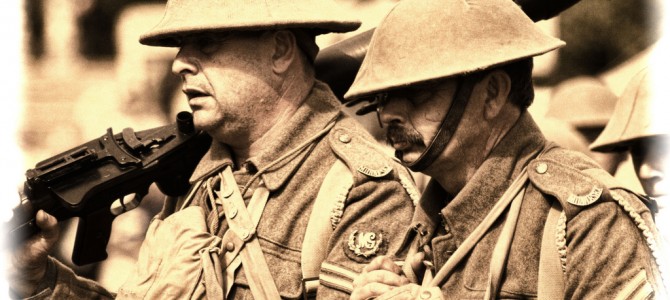
One hundred years later, World War I still provokes confusion and controversy. Scholars can’t even agree on who started the war, with major books accusing Russia, France, Britain, and Austria and Germany. If no one knows who started it, everyone agrees how it ended: A vengeful France and Britain imposed massive and unpayable reparations on Germany resulting in the collapse of the German economy and the rise of the Nazi Party.
This view owes its popularity to none other than economist John Maynard Keynes. Before he was duking it out with Friedrich Hayek over questions of recession and economic stimulus, Keynes served as a delegate to the Paris Peace Conference. Frustrated that he failed to find support for his proposals to rebuild the European economy, Keynes resigned halfway through the conference and wrote a book entitled “The Economic Consequences of the Peace,” in which he argued that the Versailles Treaty was a “Carthaginian Peace” which would impoverish Germany and Europe, leading to another war. It rapidly became a bestseller in Europe and America, leading to disillusion with the treaty in the English-speaking world.
It’s a good time to challenge conventional wisdom on the war, and that includes asking: Was the Versailles Treaty really so unfair, and did it actually cause World War II?
Reparations Were Not New
The idea of demanding reparations was not new. When Prussia defeated France in the Franco-Prussian War of 1870-71, it appropriated Alsace-Lorraine and imposed war reparations of five billion gold francs to be paid within five years. German troops continued to occupy French territory until the indemnity was paid in full, with the result that France paid off the entire sum early.
During the first weeks of World War I, German Chancellor Bethmann Hollweg composed a set of war aims which included significant territorial acquisitions and also cash reparations so heavy that “France is incapable of spending considerable sums on armaments for the next eighteen to twenty years.”
When the Soviets toppled the Tsarist government in Russia and sought a separate peace with Germany, territorial acquisitions and reparations in both cash and commodities were at the top of the German list of demands. Russia lost 90 percent of its coal, 50 percent of its industry and 30 percent of its population. The Central Powers took possession of Ukraine’s grain reserves: one million rail cars of grain destined for Austria alone. They also imposed cash reparations to the tune of nine billion gold marks. With the British naval blockade causing severe shortages of basic commodities in Germany, stripping its defeated adversaries of resources was essential to the war effort.
World War I Was Different
Many in France and Britain would have been happy to follow the German example and impose reparations designed to cripple Germany’s economy and prevent it from pursuing expansionist aims in the future. President Woodrow Wilson, however, insisted that the treaty only seek compensation for damage to civilian property in France and Belgium.
At first blush, even this may sound unfair. Why should only one side see its damage paid for? It’s important to understand, however, the strange asymmetry that the victors in World War I faced.
The war began with a massive German invasion of Belgium and northern France. France halted the German advance just short of Paris in the Battle of the Marne, and Allied troops regained some lost territory; however, the largely static fighting on the Western Front over the next four years was entirely on French and Belgian territory.
Constant shelling left the area of the front so scarred that craters and trench lines can still be seen in the French countryside to this day. Towns that were swept over by the front were obliterated. This was exacerbated by a German scorched-earth policy. When the German army pulled back to the Hindenburg Line after the battle of the Somme, engineer companies systematically pulled down buildings, cut trees, poisoned wells and set booby traps in the areas being evacuated. In the town of Bapaume, the city hall was one of the few structures left standing by withdrawing German troops, until a massive delayed action bomb in the basement went off several days later, killing a Australian troops and French civilians who had gathered for a ceremony in honor of the town’s liberation.
Damage was not limited to the front itself. Popular propaganda during the war trafficked in lurid tales of German soldiers cutting off the hands of Belgian babies or crucifying Allied soldiers. After the war, the realization that these stories had been false led to an opposite reaction: In the English-speaking world, people discounted all stories of German misbehavior in occupied France and Belgium. However, the German invasion and occupation was needlessly destructive in many ways.
Based on their experience invading France in 1870-71, the German Army was terrified of guerrilla snipers. Officers followed a policy of severe reprisals, putting suspects before firing squads and burning down houses or whole villages in retaliation for alleged shots fired at soldiers. On August 25th, 1914, German soldiers killed 248 residents of the Belgian city of Leuven, expelled the remaining 10,000 citizens, and burned the town, including the university library containing 300,000 irreplaceable medieval manuscripts.
Germans Exploit Occupied Territory
After the invasion this sort of atrocity ceased, though the firing squad remained the standard penalty for a whole range of “crimes,” from sheltering fugitive French soldiers to raising pigeons which might be used for carrying messages. A new sort of exploitation set in, however, as the occupation became long term.
Belgium and northern France were a heavily industrial area, and German occupation forces set about stripping the area of resources, leading to massive food and fuel shortages. Many factories were dismantled and shipped to Germany. Individual towns and cities were assigned indemnities to be collected from civilians’ savings and turned over to the occupation authorities. During July 1915 an indemnity of one million marks was levied on Sedan while the residents of Lille were ordered to pay three million. Basic household goods were extracted from the civilian population—linens, cooking pots, china, and furniture—and civilians were required to quarter soldiers in their homes.
In addition to requisitions of material goods, German occupation authorities increasingly requisitioned the time and labor of the occupied population. A common punishment for minor infractions was being shipped to Germany to perform forced labor. Young men of military age were drafted into labor battalions and assigned work, including repairing trenches and burying the dead at the front. Sometimes this forced labor was combined with additional humiliations. When 20,000 women and girls were shipped out of Lille in April 1916, they were all forced to undergo the same gynecological examination by German army doctors usually inflicted on registered army prostitutes.
After four years of economic and social exploitation of occupied areas, the victorious Allies found themselves in a strange position. Germany had clearly lost the war. Their civilian population was in revolution, the navy in mutiny, and the army in retreat. Allied troops were rapidly liberating territory held by Germany since 1914. But when the German government agreed to armistice terms, Allied troops had yet to make any significant advances onto German soil. The Allies had won, but nearly all of the war’s destruction had fallen upon the victors.
Given all this, the demand for some degree of reparations becomes more understandable. The Allied commitment to help rebuild Germany after World War II wasn’t just the result of less anger towards Germany than in the prior war. It was a realistic response to the fact that German cities and the German economy had been utterly destroyed. In World War I, it was France and Belgium which had suffered that level of destruction, while Germany had benefitted from stripping away their resources during four years of occupation. Reparations were simply a way to try to right the injustices of the occupation and help the more injured party recover from the war.
Keynes Was Wrong About This, Too
All this serves to explain why the Allies wanted some form of reparations. But were the actual reparations imposed (132 billion gold marks to be paid over 30 years) so massive that they destroyed the German economy and led to the rise of the Nazi Party? The evidence suggests that they were not.
During World War II, French economist Étienne Mantoux wrote a book critiquing Keynes’ more famous volume: “The Carthaginian Peace, or the Economic Consequences of Mr. Keynes.” Mantoux pointed out that while Keynes had been right about the outbreak of another war, his actual economic predictions about the consequences of the reparations had almost all been wrong. Keynes predicted that coal and iron production would be driven down, but instead they increased. He predicted that the German savings rate would remain very low, but instead it grew rapidly.
Most certainly, the reparations were wildly unpopular in Germany, and the Weimar Republic made efforts to have their liability reduced. The Allies made repeated concessions, reducing the amount of reparations owed and finally cancelling them altogether shortly before Hitler came to power and repudiated further reparations unilaterally. All told, Germany paid roughly 20 billion gold marks worth of reparations between 1921 and 1932, roughly 2.4 percent of Germany’s national income during that period. As Mantoux pointed out, immediately after repudiating the reparations, the new Nazi government began a re-armament program which consumed a significantly larger percentage of national income than reparations ever had.
Reparations did not cripple the German economy, nor did they directly lead to the ascendency of the Nazi Party. The economy suffered hyperinflation in 1923, but hyperinflation was a problem faced by Austria as well, even though it had been excused from reparations payments because of its inability to pay. The monetary collapse was primarily a result of fiscal indiscipline and the massive debts racked up during the war to pay for armaments. What reparations did do was provide a focus for the resentments of a portion of German society which refused to admit that they had lost the war.
This “stab in the back” faction, which blamed Jews and socialists for Germany’s humiliation, was active in German politics even before the ink was dry on the peace treaty. It had particular appeal to returned soldiers, many of whom sought a continuation of the camaraderie they had found in the army by joining political paramilitary groups known as freikorps. Although the Weimar Republic sought to integrate itself back into Europe, it had opened the door to nationalist violence at its very inception by seeking the aid of the freikorps in crushing communist revolutions in various parts of Germany.
Reparations did not help to diffuse the resentment which simmered in German nationalist circles, but given that those resentments were at having lost the war, virtually nothing the Allies could have done would have resolved them—except perhaps the bloody process of pushing all the way to Berlin, which the Allies performed 25 years later.









